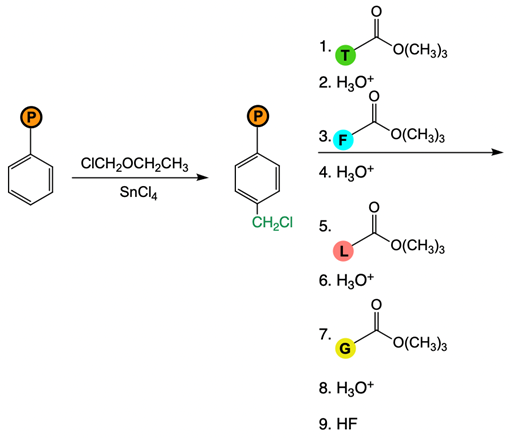Hey everyone. So, when we're talking about the Merrifield peptide synthesis method, we're gonna see that it has 4 required steps. Now, step 0 is not part of these 4 required steps, that's just prep work that we do outside of this process. In it, we're gonna have amino acid protection. So a condensation reaction occurs between a carboxylic acid and the N-terminus end of an amino acid.
So here's our carboxylic acid and the amino acid. It's a condensation reaction, so we have the loss of water. And in this process, we created our protected amino acid. Here, we have added this silyl group to our amino group to protect it. And what we're gonna say next is step 1 finally, we have an SN2 process, where the protected amino acid reacts with a chloromethylated polystyrene bead.
To show the polystyrene chain in a simple five version, we just have this "P" here. And what's gonna happen is this oxygen comes in, hits here, and kicks out the CH2Cl from the CH2, and we've attached this protected amino acid to this polystyrene bead. So here it goes. This leads us to step 2, which is a hydrolysis reaction where we have the deprotection of the N-terminus end of the amino acid.
So, basically, we're gonna remove the acyl protecting group here, exposing that amino acid. So now we have that unprotected amino acid. And at this point, you're gonna go into the cyclic part of the Merrifield synthesis process. We're gonna attach as many amino acids as we want to exposed amino acid ends.
And this can go several times. We could do 3a to 3b, back to 3a to 3b over and over again as many times as we want. So here we're going to say that 3a is our peptide bond formation, which is another protected amino acid attaches to the N-terminus end of the amino acid. This is done with the help of DCC, which will help to adsorb the water that's lost. And we're gonna say here, we lose water.
So remember, this is just a simplified way of explaining what's going on. DCC there has just helped to facilitate this process to happen. And we're gonna say here, losing that water gives us now this carbonyl connected to the amino group. It still has its alpha carbon and R group. And then we're gonna have this still protected and here.
So we have this structure here. Now, we can go into hydrolysis for part 3b, which again remember is the deprotection of the N-terminus end of the amino acid. So all that is is us removing this acyl group. So when we do that, we get this unprotected amino end. Now, again, we can go if we wanted this way and react with yet another protected amino acid, increasing the chain length, or instead, I can just book it this way and just use HF and end the process.
Here, we're gonna say, step 4 is the peptide chain release. The peptide chain is released upon treatment with hydrofluoric acid. This would sever this connection of the growing amino acid chain from the polystyrene bead. When we do that, we've exposed now the peptide chain. We'll just add the rest of what's attached.
So there goes my dipeptide that I've just formed. We'd also have the rest of the structure as waste. So that benzene is still there. So I have the CH2 group, and it would combine with the Fluorine from the HF. But here, we don't really care too much about the structure; we care about the peptide that I just made.
Alright. So this is the Merrifield peptide synthesis process.



